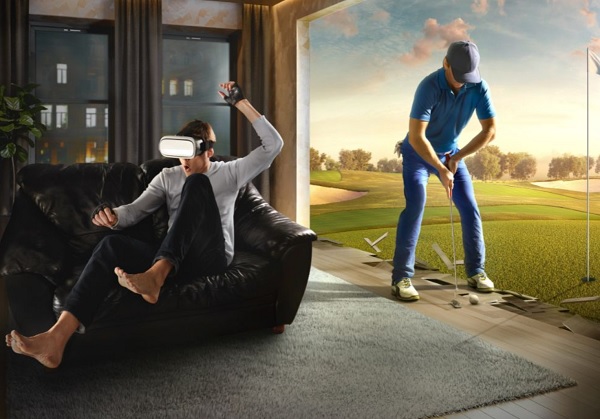Over the past few years, virtual reality has emerged as a significant innovation in numerous sectors, including entertainment, education, and healthcare.

The world of sports has not been an exception. Golf, a game with a deep history and tradition, is now stepping into the future with VR technology’s help.
Let’s see how VR is being used in golf, transforming the way players train, learn, and enjoy this popular sport.
The Intersection of Golf Simulators and VR
A golf simulator traditionally provides a platform for golfers to play a simulated round of golf in an indoor setting. Utilizing a combination of radar, sensor technology, and 3D imaging, these simulators can replicate a realistic golf environment, providing players with an opportunity to practice their swing or play a full round, regardless of outdoor weather conditions.
However, while conventional golf simulators can create a digital rendition of a golf course on a screen, the introduction of VR has added an entirely new level of immersion and interaction to this experience.
Immersive Golf Training
These virtual golf platforms offer realistic simulations of famous golf courses from around the world, with detailed rendering of fairways, greens, bunkers, water hazards, and even the surrounding scenery. Players can practice their swing and strategy on a variety of holes and conditions without leaving their homes.
Some advanced VR golf systems also provide real-time analytics on each swing, including data on swing path, clubface angle, impact speed, and ball trajectory. These insights are invaluable for identifying weaknesses in a player’s swing and working on specific areas for improvement.
Enhancing Immersion with VR Golf Simulators
In a VR golf simulator, the player wears a VR headset, which places them directly inside the virtual golf course. This immersive environment replicates not only the look but also the sounds and, to some extent, the feel of a real golf course. As players look around, they can see the course stretching out in all directions, just as they would in real life.
To swing the club, players use VR controllers that simulate the weight and movement of a golf club. Some advanced systems even use haptic feedback technology to reproduce the feel of the club striking the ball, adding an extra layer of realism.
Training and Analytics
What sets VR golf simulators apart from traditional ones is their ability to gather and analyze data. They can provide detailed analytics on every swing a player makes, including data on the swing path, clubface angle, impact speed, and ball trajectory. With this information, players can gain a better understanding of their swing mechanics and identify areas for improvement.
Moreover, with machine learning and artificial intelligence integration, these systems can offer personalized training programs based on the analyzed data. This can help players target their weaknesses more effectively and track their progress over time.
Expanding the Golf Community
With the increasing accessibility of VR technology, more people can enjoy the experience provided by VR golf simulators. This not only helps seasoned players maintain their game during off-seasons or poor weather, but it also introduces newcomers to the sport in a fun, engaging, and low-pressure way. Consequently, VR golf simulators are expanding the golfing community and fostering a new generation of golf enthusiasts.
The merging of VR with golf simulators is truly revolutionizing the way we perceive and play the sport. The technology is not just providing an alternative to the traditional golfing experience but is also enhancing training, making coaching more accessible, and increasing participation in the sport. As VR technology continues to evolve, we can expect even more exciting developments in the world of virtual golf.
Remote Coaching
VR technology also offers promising possibilities for remote coaching. Traditionally, golf coaching required physical presence for observation and instruction. With VR, however, a coach can remotely observe a player’s performance in the virtual environment and provide immediate feedback.
In addition to visual observation, the biomechanical data collected by VR systems can aid in a deeper analysis of a player’s swing mechanics. This capability makes professional coaching more accessible and convenient, potentially helping many more players improve their game.
Engaging Gaming Experiences
While training and coaching are serious applications of VR in golf, it’s also creating a fun and engaging gaming experience for golf enthusiasts. Casual players or those new to the sport can play a round of golf on world-class courses virtually, enjoying the game without the pressures of real-world golf.
Multiplayer options allow friends to compete against each other, regardless of geographical location. Furthermore, integrating VR golf games with social media platforms makes it easy to share scores, encourage a little friendly competition, and foster a community of virtual golfers.
Accessibility and Inclusivity
Finally, VR is making golf more accessible and inclusive. Not everyone has the time, resources, or physical ability to play on a real golf course. VR golf experiences remove these barriers, allowing anyone with a VR headset to enjoy golf, learn the basics, or train like a pro.
Takeaway
VR is transforming golf in fascinating ways, offering immersive training tools, enabling remote coaching, and creating fun and accessible gaming experiences. As the technology continues to evolve, the links between the digital and physical realms of golf will likely become even more intertwined, and the possibilities for VR in golf will expand further. Whether you’re a seasoned golfer or a curious beginner, it’s an exciting time to be involved in the sport.